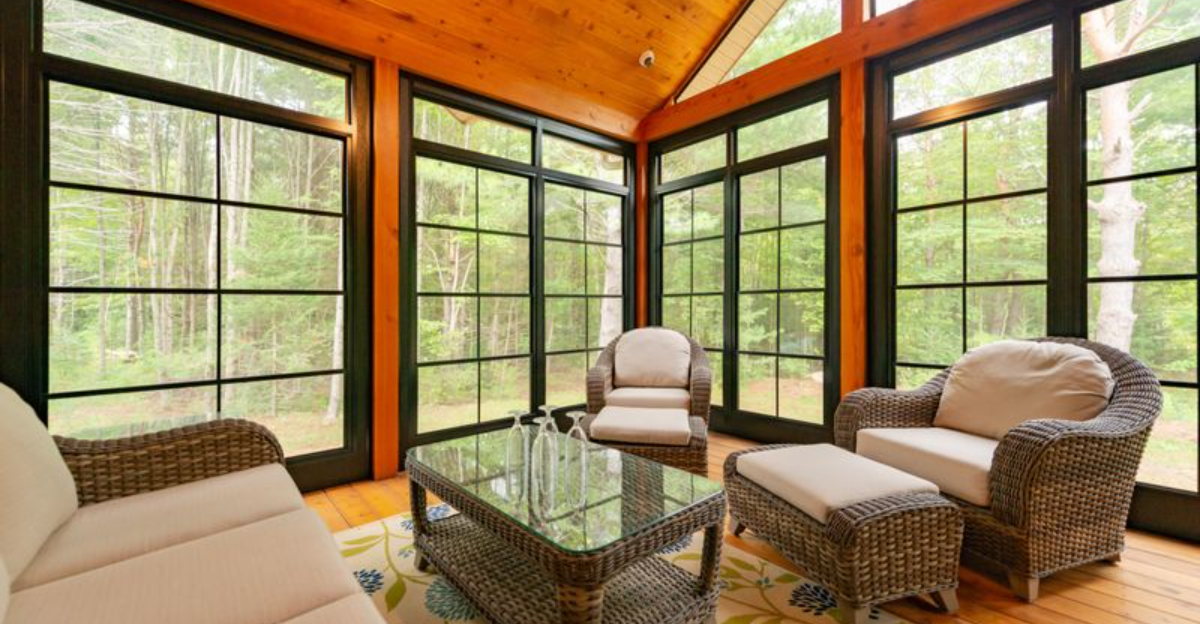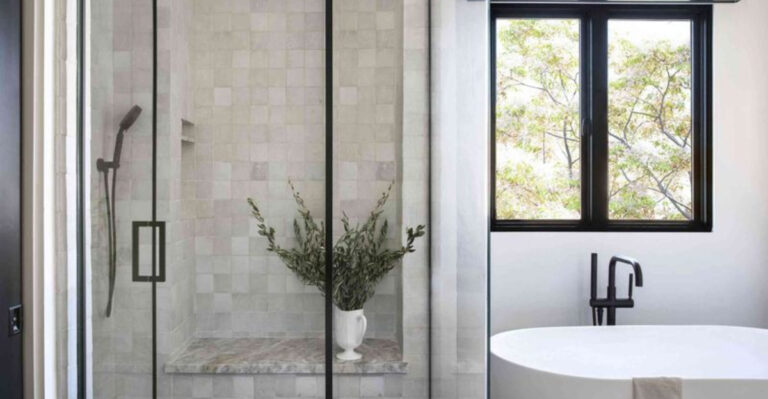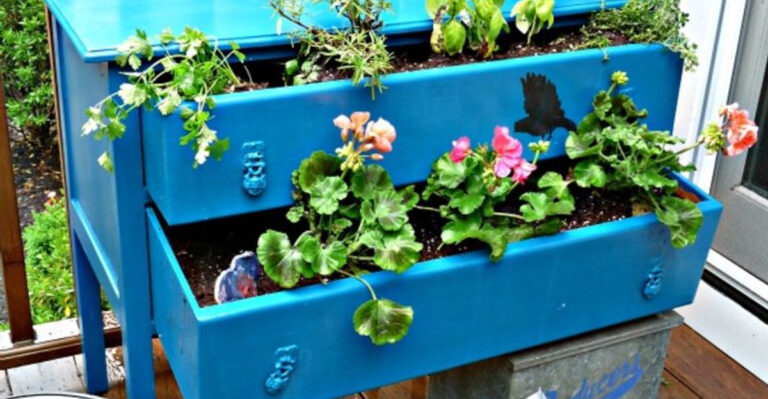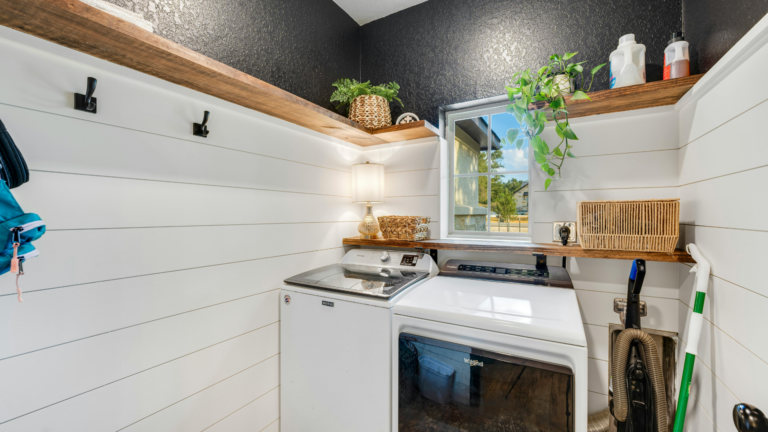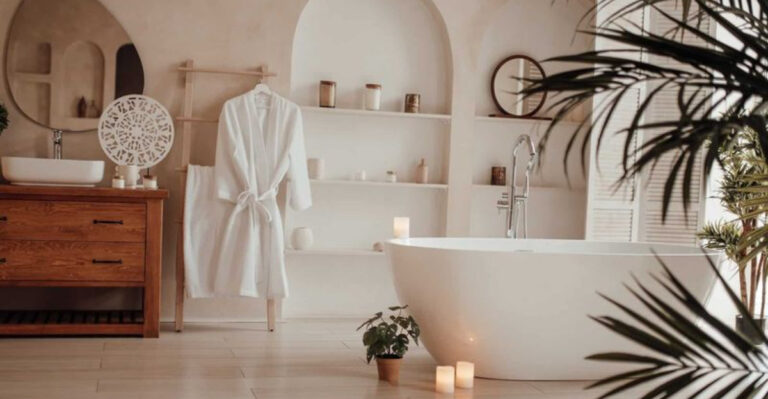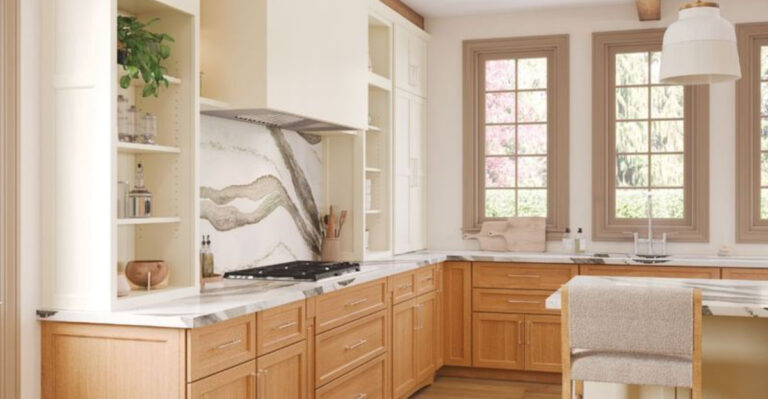17 Expert Ways To Handle Four-Season Sunrooms
I didn’t realize how much I’d love having a four-season sunroom until I had one, and now I can’t imagine living without it. It’s where I sip coffee on frosty mornings and watch summer storms roll in without breaking a sweat.
But making it truly comfortable year-round took more than just throwing in a few chairs. Between battling the winter chill and taming the summer heat, it needed a little extra love.
With the right setup, though, this glass-walled space has become my favorite place in the house, no matter what the weather’s doing outside. It’s cozy, bright, and always inviting.
1. Smart Temperature Control Systems

Zoned thermostats work wonders in sunrooms where temperatures fluctuate more than other areas of your home. Install a dedicated HVAC zone with its own controls to manage the unique climate needs of your glass-enclosed space.
Many homeowners swear by programmable systems that adjust automatically throughout the day as the sun moves across the sky. This prevents both overheating and overcooling, saving energy dollars.
Consider smart thermostats that learn your preferences over time and can be controlled remotely when you’re away from home.
2. Ceiling Fan Magic
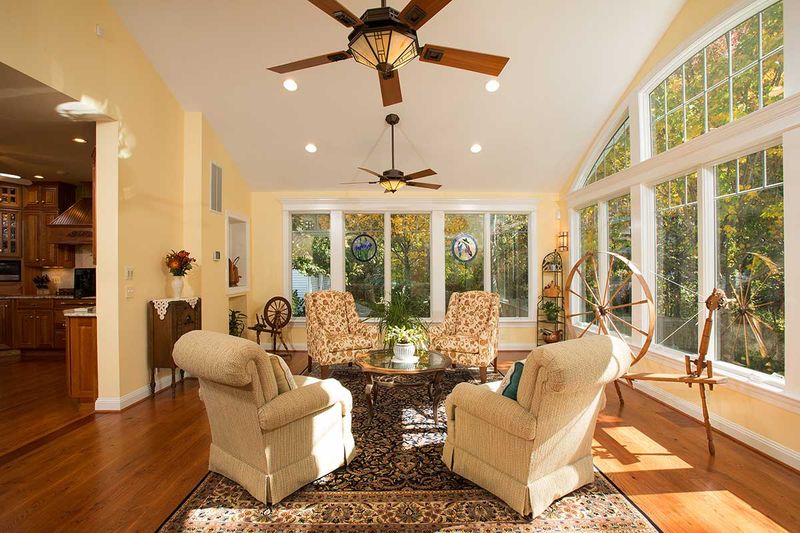
Ceiling fans create gentle air movement that makes sunrooms feel up to 8 degrees cooler in summer without touching the thermostat. Look for models with reversible motors to push warm air downward during winter months.
Proper blade size matters! A room measuring 12×12 feet needs a 42-inch fan, while larger spaces require 52 inches or more for effective circulation.
The ideal height is 8-9 feet above the floor with at least 7 feet of clearance below. Bonus points for fans with humidity sensors that automatically adjust speed based on moisture levels.
3. Window Film Solutions

Specialized window films block up to 99% of harmful UV rays while reducing heat gain by 70%. They protect furniture from fading and keep your sunroom comfortable without sacrificing the view.
Choose ceramic or spectrally selective films for the best balance of light transmission and heat rejection. Some newer options even change their properties seasonally, allowing more warmth in winter!
Application is surprisingly DIY-friendly with basic tools and patience. Most films last 10-15 years before needing replacement, making them a smart long-term investment for sun control.
4. Flooring That Performs

Thermal mass matters! Tile, stone, or concrete floors absorb heat during sunny days and release it slowly when temperatures drop. This natural temperature regulation helps maintain comfort without cranking up your heating system.
Look for materials with solar absorption ratings above 0.7 for maximum efficiency. Dark colors capture more heat, while lighter shades reflect it, so choose based on your climate needs.
Radiant floor heating systems work beautifully in sunrooms, providing consistent warmth from the ground up during chilly months without unsightly radiators or vents.
5. Multi-Layer Window Treatments
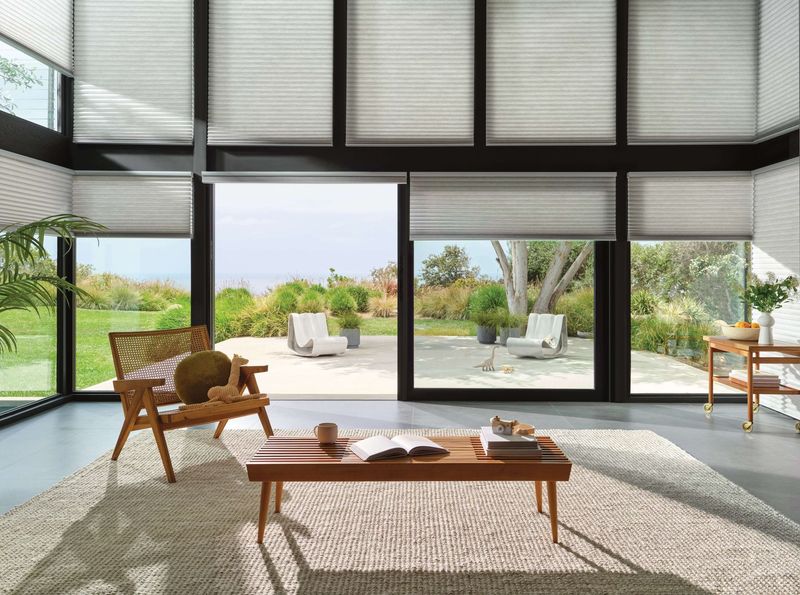
Layered window coverings give you ultimate control over light, privacy, and temperature. Start with cellular shades that trap air in honeycomb pockets for insulation, then add decorative drapes for style and additional temperature control.
Motorized options let you program your coverings to open and close with the sun’s movement, maximizing natural heating in winter mornings and preventing afternoon overheating in summer. Some systems even connect to weather stations!
For maximum efficiency, choose light-colored backings that reflect heat outward during summer and dark-facing fabrics that absorb warmth in winter.
6. Furniture That Adapts

Weather-resistant wicker looks fantastic while standing up to humidity swings common in sunrooms. Modern synthetic versions won’t crack or fade like their natural counterparts when exposed to intense sunlight.
Modular pieces allow you to reconfigure your layout seasonally. In winter, create cozy conversation groupings near heat sources. Summer calls for more open arrangements that maximize air circulation and take advantage of cross breezes.
Choose fabrics treated with UV protectants to prevent fading, and look for cushions with quick-dry foam that won’t harbor mildew if humidity levels spike.
7. Humidity Heroes

Sunrooms battle unique humidity challenges as glass walls create greenhouse effects. A dedicated dehumidifier keeps summer moisture in check, preventing that sticky feeling and protecting wood furnishings from warping.
Winter brings the opposite problem when heating systems dry the air excessively. A humidifier maintaining 40-50% humidity prevents static electricity, keeps plants happy, and makes the space feel warmer at lower temperatures.
Smart humidity monitors connected to your phone alert you when conditions drift outside optimal ranges, letting you address issues before they become uncomfortable.
8. Plant Placement Strategy

Strategic greenery acts as natural temperature regulators! Leafy plants release moisture through transpiration, creating microclimate cooling effects during hot months. A single medium-sized plant can release up to a quart of water daily!
Arrange taller species on southern exposures during summer to provide natural shading without blocking views. Potted trees on casters can be repositioned seasonally to maximize or minimize sun exposure as needed.
Choose plants with varying light requirements. Succulents thrive in direct sun spots while peace lilies flourish in areas that receive filtered light, allowing you to beautify every corner.
9. Ventilation Variations

Cross-ventilation transforms stuffy sunrooms into breezy retreats. Install operable windows on opposite walls to create natural airflow paths that can lower temperatures by 10 degrees without mechanical cooling.
Ceiling vents with temperature-activated openers release trapped heat automatically when the mercury rises. Some models even include rain sensors to close at the first drop, protecting your space during sudden showers.
For year-round comfort, consider heat recovery ventilators that exchange stale indoor air with fresh outdoor air while transferring heat between the two streams, maintaining temperature while improving air quality.
10. Seasonal Decor Rotation

Swapping textiles seasonally creates psychological comfort that enhances physical comfort. Cool blues and lightweight linens make summer heat feel less oppressive, while warm oranges and chunky knits bring cozy vibes to winter days.
Area rugs serve double duty as both style elements and practical insulators. Layer thicker rugs over tile floors during winter to prevent heat loss, then roll them away in summer to expose cooling thermal mass.
Rotate accessories that reflect the changing views outside your glass walls. Seashells and coastal elements for summer give way to pinecones and woodland touches as leaves fall.
11. Reflective Roof Coatings

White elastomeric roof coatings bounce back up to 90% of solar radiation that would otherwise become heat. Applied to sunroom roofs, these reflective surfaces can lower interior temperatures by 20-40 degrees during peak summer days.
Most coatings apply like thick paint but form a rubberized membrane that stretches and contracts with temperature changes. This flexibility prevents cracking and leaking while maintaining reflective properties for years.
Look for products with Energy Star ratings and high SRI (Solar Reflectance Index) values above 100 for maximum cooling benefits and potential utility rebates.
12. Portable Heating Solutions
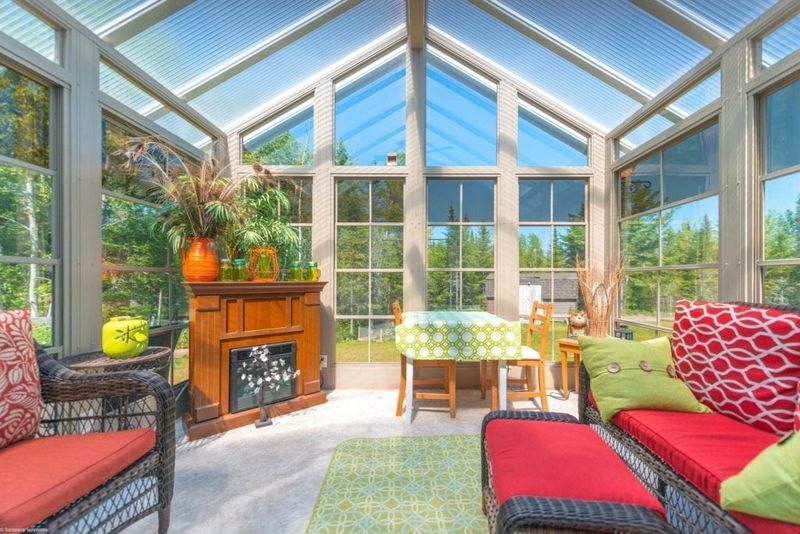
Infrared heaters warm people and objects directly without wasting energy heating all the air in your sunroom. They work like sunshine, providing immediate comfort even in glass-surrounded spaces where traditional heaters struggle.
Look for models with tip-over protection and thermostatic controls for safety. Some newer units even mimic the appearance of artwork or furniture when not in use, blending seamlessly into your decor.
For outdoor-inspired ambiance, ventless ethanol fireplaces create dancing flames without chimneys or gas lines. They generate real heat while adding a cozy focal point that draws family and friends together on chilly evenings.
13. Insulation Innovations
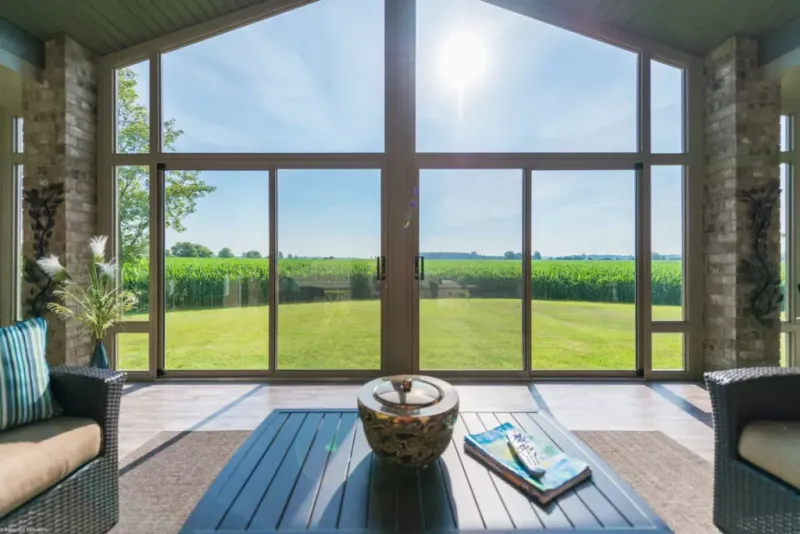
Clear insulating films applied between double-pane glass panels boost R-values by up to 30% without blocking views. This technology creates an invisible thermal barrier that keeps heat where you want it—inside during winter and outside during summer.
Spray foam insulation in roof cavities and along joining walls between your sunroom and main house prevents thermal bridging. The expanding foam seals tiny gaps that allow costly energy transfer.
Thermal curtains with reflective backings hung on exterior-facing walls during extreme temperature events provide temporary insulation boosts when weather turns unusually harsh.
14. Automation Advantages
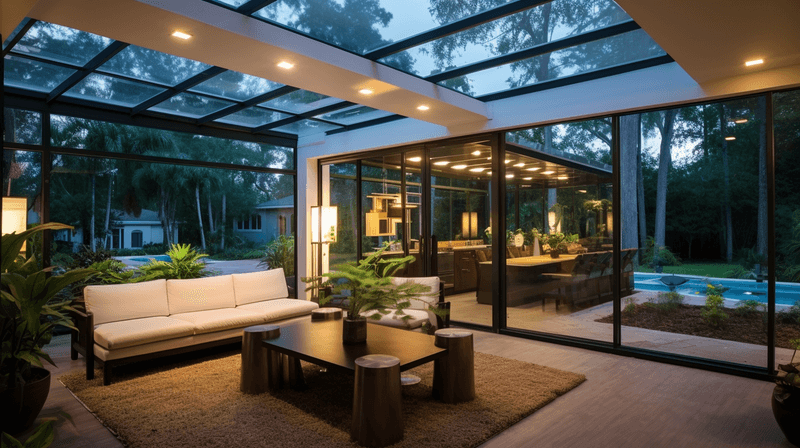
Smart home systems that anticipate sunroom needs make comfort effortless. Sensors detect changing conditions and trigger appropriate responses—closing shades when sun intensity peaks or activating ventilation when humidity rises.
Schedule-based controls adjust your environment throughout the day without constant manual intervention. Program morning warm-ups in winter and afternoon cooling in summer to arrive at a perfectly comfortable space.
Voice-activated assistants connect with compatible devices, allowing you to adjust lighting, temperature, and window coverings with simple commands while relaxing with your morning coffee or evening book.
15. Lighting Layers
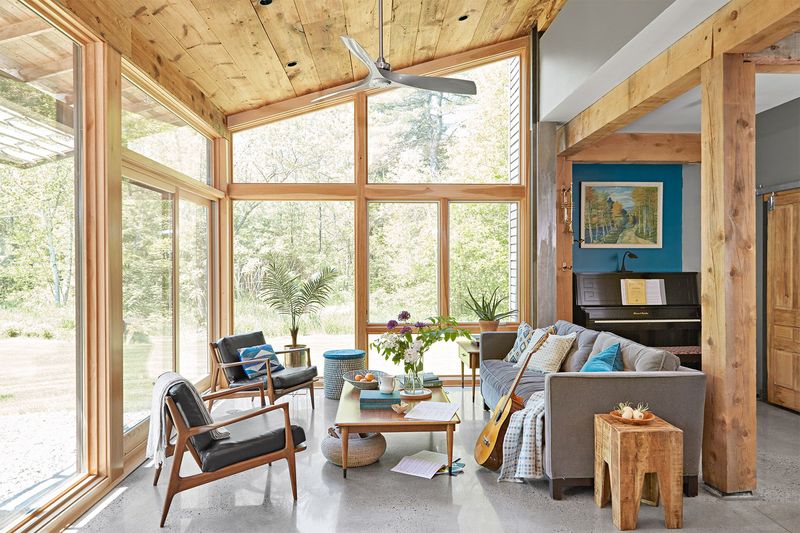
Thoughtful lighting transforms sunrooms from daytime havens to nighttime retreats. Install dimmable recessed fixtures for overall illumination that won’t create glare on glass walls after dark.
String lights draped along ceiling beams create magical ambiance for evening entertaining. Choose LED versions with color temperature options that shift from energizing cool white for daytime to relaxing warm white for evenings.
Solar-powered landscape lighting positioned outside your sunroom illuminates your nighttime view, preventing the dreaded “black mirror” effect when darkness turns windows into reflective surfaces.
16. Privacy Without Sacrifice
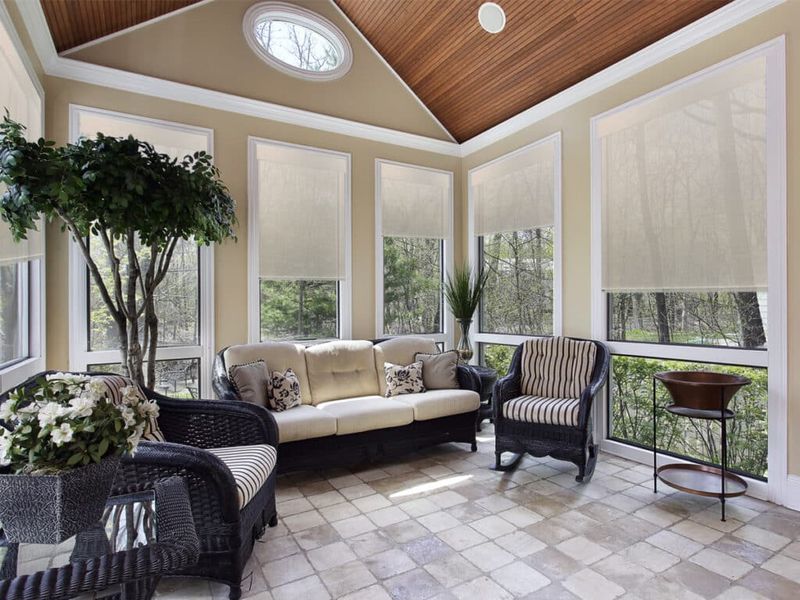
Bottom-up shades offer the perfect compromise between privacy and views. They rise from the sill rather than dropping from the top, blocking sightlines from outside while preserving your view of treetops and sky.
Decorative window films with frosted or patterned designs create privacy without blocking light. Many options feature beautiful botanical or geometric patterns that enhance your decor while obscuring the view in.
Strategic landscaping outside your sunroom provides natural screening. Ornamental grasses grow quickly and move beautifully in the breeze, while deciduous shrubs offer summer privacy but allow welcome winter sunlight after leaves drop.
17. Entertainment Integration
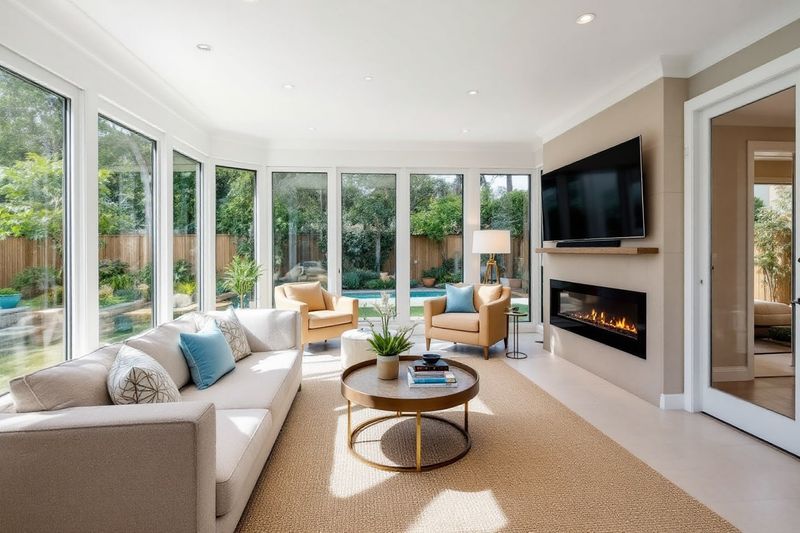
Weather-resistant television mounts with anti-glare screens make movie nights possible even in glass-surrounded spaces. Look for models rated for humidity exposure and position them away from direct sunlight.
Hidden speaker systems deliver immersive sound without visible equipment cluttering your space. In-ceiling or in-wall options disappear into your architecture while providing excellent audio quality for music or movie soundtracks.
Outdoor-rated projector screens that descend from ceiling recesses transform your sunroom into an occasional theater. Project onto exterior walls at night for an indoor-outdoor cinema experience your neighbors will envy!

